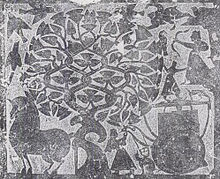|
Longma
The longma is a fabled winged horse with dragon scales in Chinese mythology. Seeing a longma was an omen of a legendary sage-ruler, particularly one of the Three Sovereigns and Five Emperors. Name  The Chinese word longma combines long 龍 "dragon" and ma 馬 "horse". Compare hema 河馬 (lit. 'river horse') "hippopotamus" and haima 海馬 (lit. 'sea horse') "seahorse". In addition to naming the mythic creature, longma 龍馬 "dragon horse" can refer to an eminent person, such as in the four-character idiom longma jingshen 龍馬精神 ("vigorous spirit in old age"). Longma interconnects traditional Chinese beliefs about dragons and horses. An early example comes from the Zhouli (周禮; 'Rites of Zhou'), which differentiates names for horses of different heights, measured in the chi 尺; 'Chinese foot' (historically around 23–33 centimeters, see Chinese units of measurement). Horses up to 8 feet tall are called long 龍 "dragon", those up to 7 feet are called lai 騋, and those up to 6 feet are called ma 馬; 'horse'. The Han dynasty scholar Wang Chong says, "The people paint the dragon's shape with a horse's head and a snake's tail (世俗畫龍之象,馬頭蛇尾。)."[1] Edward H. Schafer describes the horse's "tremendous importance" to Tang dynasty rulers for military tactics, diplomatic policy, and aristocratic privilege.
This "steed" refers to Tang Sanzang's famous bailongma 白龍馬 "white dragon horse". The Japanese loanword ryūma or ryōma 龍馬 (simplified 竜馬) has several meanings. Ryūma refers to the legendary Chinese "dragon horse" and the name of a chess piece in shogi (translated "promoted bishop", also pronounced ryūme). Ryōma is commonly used as a Japanese name, for instance Sakamoto Ryōma. See Visser for details about the dragon-horse in Japan.[3] Classical referencesMany Chinese classic texts refer to the longma "dragon horse". The most famous longma occurrences are connected with the mythical Hetu 河圖 "Yellow River chart", which along with the Luoshu 洛書 "Luo River writing; Lo Shu Square" are ancient magic square arrangements of the Bagua "8 Trigrams" and Wuxing "5 Phases". They are traditionally linked with prehistoric Chinese rulers, a longma revealed the Hetu to Fu Xi or Shun, and the shell of a gui 龜 "tortoise" revealed the Luoshu to Yu. "The Great Treatise" commentary to the Yijing explains.
"The water of the Ho sent forth a dragon horse; on its back there was curly hair, like a map of starry dots", says the Yijing commentary,[5] "The water of the Lo sent forth a divine tortoise; on its back there were riven veins, like writing of character pictures." Hetu 河圖 is alternately named longtu 龍圖 and matu 馬圖, with "dragon" and "horse". For instance, the Baihutong 白虎通 (封禪) says 河出龍圖 "the Yellow River sent forth the dragon chart" while the Liji (禮運)[6] says 河出馬圖 "the Yellow River sent forth the horse chart". The Shujing (顧命)[7] records the original Hetu "river plan" among the royal treasures of King Cheng of Zhou (r. c. 1042–1021 BCE). Kong Anguo's Shujing commentary explains the longma.
The Bamboo Annals which record ancient Chinese mythology and history describe the longma in a context of Yao conveying the throne to Shun. The spirits of the five planets appeared on the Yellow River and predicted, "The river scheme will come and tell the emperor of the time. He who knows us is the double-pupilled yellow Yaou." (Yao supposedly had double-pupil eyes, indicating insight). The Yellow River gave off light, beautiful vapors, and clouds.
A subsequent Bamboo Annals context describes the spirit of the Yellow River as a person rather than a dragon-horse, and says Yao rather than Yu received the Hetu in order to control the Great Flood.
The 4th-century Shiyiji (拾遺記)[11] records that Emperor Mu of Jin, "drove around the world in a carriage, drawn by eight winged dragon horses." This context uses the modified expression long zhi jun 龍之駿 "dragon's excellent-horse". The 10th-century Taiping Imperial Reader says a longma that appeared in 741 was considered as a good omen for Emperor Xuanzong of Tang.
Comparative mythology Longma or "dragon horse" connects with other creatures in Chinese folklore. While longma sometimes applies to the Qilin,[13] the closest relative is the legendary tianma 天馬 "heavenly horse" or the "Chinese Pegasus", which was metaphorically identified with the hanxuema 汗血馬 "blood-sweating horse" or Ferghana horse. A poem attributed to Emperor Wu of Han celebrates a 101 BCE victory over Western tribes.
In Chinese astrology, the Dragon and Horse are two of the twelve animals. A Zhuangzi (列禦寇) story mentions finding a "pearl worth a thousand pieces of gold" under the chin of a lilong 驪龍 "black-horse dragon". Some mythic elements of the longma "dragon horse" are culturally widespread. Schafer elucidates:
The Chinese longma "dragon horse" is not culture-specific. Mythological hybrid animals or chimeras are known worldwide, including combinations of dragons and horses. In Greek mythology, the Hippocamp or Hippocampus (lit. "horse sea-monster"), which supposedly has the head and front legs of a horse and the hindquarters of a dragon or fish, parallels the longma.[16] In Babylonian mythology, "dragon-horse" is a title of the goddess Tiamat.[17] Among the prehistoric hill figures in Oxfordshire, Dragon Hill is below the Uffington White Horse. See alsoReferences
Footnotes
Further readingWikimedia Commons has media related to Dragon horse.
External links
|
||||||||||||||||||||
Portal di Ensiklopedia Dunia
